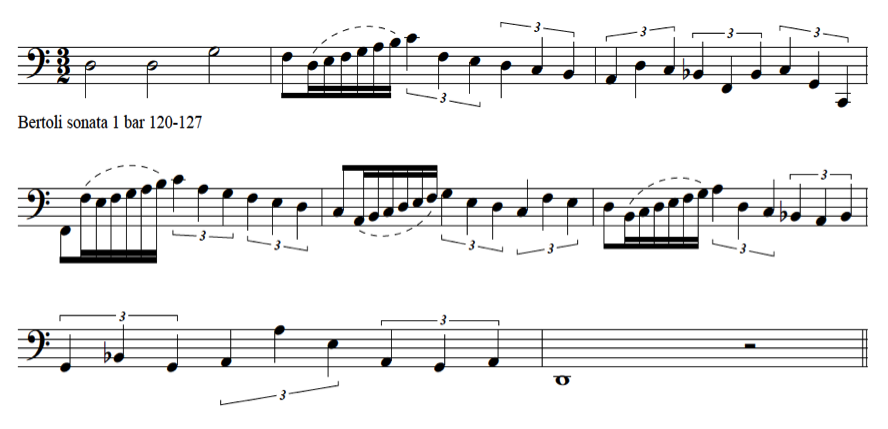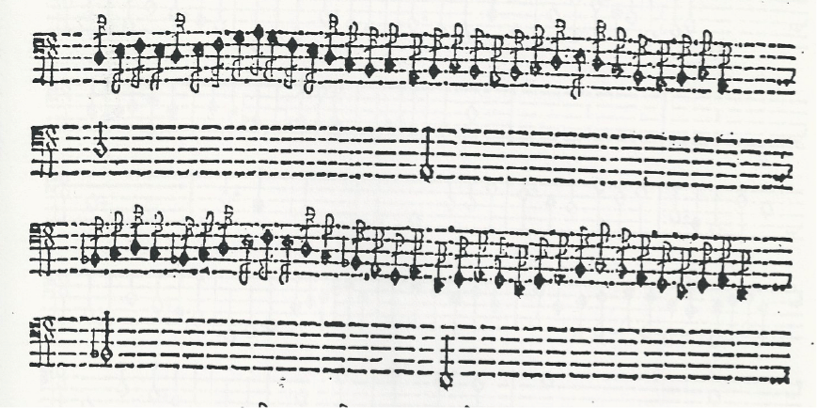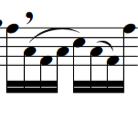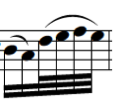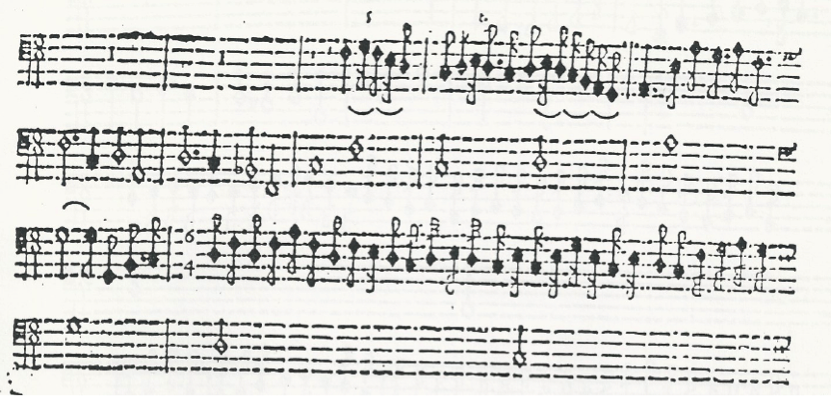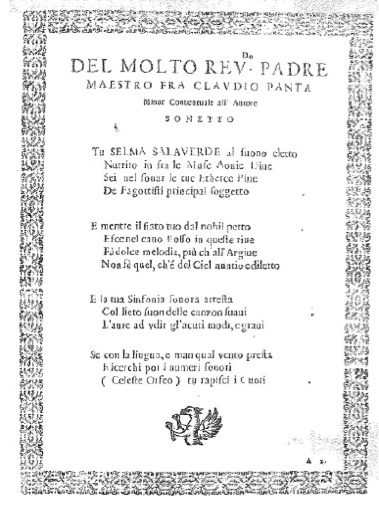Dulcian repertoire from the seventeenthth century
The seventeenth century is the period in which the emancipation of instrumental music took place. Numerous virtuoso instrumentalists, such as Andrea and Giovanni Gabrieli, Dario Castello, Giovanni Picchi and many others, commenced to compose instrumental music against the background of the San Marco chapel in Venice. At first they wrote these compositions for their own use, to be played in the liturgy in the Basilica di San Marco, the chapel of the Doge. In time, this new genre spread rapidly throughout Europe. New musical forms such as the Sonata, the Canzona and the Fantasia emerged, and would never disappear again.
In instrumental repertoire from the beginning of the seventeenth century, we can clearly recognize the influence of the vocal diminutions from the sixteenth century: The diatonic diminutions in 8th notes going a third up and back (fig.11letter a), or the filling in of the octave in 16th notes (fig.11 letter b).
a) b)
Fig.11 Excerpt from Susana ung giur by Dalla Casa, 1584
Fig.12 Excerpt from Susana Pasegiata per basso solo by De Selma, 1638
These two examples are compositions based on the same madrigal Susanne un Jour by Orlano di Lasso (c1532-1594), but composed fifty years apart. In the second example De Selma uses the same kind of diminution patterns as Dalla Casa had used in 1584. Although in other places in the same piece, De Selma uses material that does not resemble vocal diminutions at all.
a)
Fig.13 Excerpt from Susana Pasegiata per basso solo by De Selma, 1638
As we can see at letter a in fig.13, the composer writes in a reasonably fast passage a jump down stretching over an octave, and right after another one two octaves up. This is technically demanding for a dulcian player, but rather impossible for a bass singer. It is obvious that we are dealing with instrumental repertoire.
Marin Mersenne (1588-1648) is the first to let go of the idea of Lingua Riversa as we have discussed above, the fast alteration between stronger and weaker tonguings in fast passages. In his Harmonie Universelle (1636) he seems to describe four different tonguings. I deliberately say ‘seems to’, because it is evident that he was not a wind player himself, and was relying on information from other instrumentalists. He might not have been familiar with these techniques himself. His descriptions are often very unclear and puzzling.
Mersennes mentions four kinds of articulation:[1]
1. Slurring (No example given by Mersenne). He calls it “flowing or mute[2]’”and “that it is done with the air alone”.[3]
2. Ta, ta-ra, ta-ra[4]
Fig.14
Fig. 15 Marin Mersenne, Harmonie universelle Fig.16 Jacques Hotteterre, Principes de la flute (1636) traversières (1707)
3. Single tonguing (no example given). Mersenne describes it as “done with the tongue alone, and serves for all kinds of notes except eight notes, for which the second manner just mentioned is used.”[5]
4. Slurring two-by-two
Fig.17 Example in Harmonie universelle (1636) describing two by two slurring by using
an extra a to indicate the absence of the tongue.
Mersenne’s description of slurring “…[the first articulation] is called flowing or mute [and] is done with the air alone,” resembles the description of slurring given by Ganassi more than hundred years earlier as discussed above. Unfortunately, he does not provide a musical example for slurring, as he does for the other articulations he describes. Mersenne broke with a style of articulation on a wind instrument that was common for over a century. According to his texts, the virtuosic fast movements of the tongue imitating the gorgia should be replaced by slurring two by two.
With the emergence of instrumental music, not only new genres sprang to life, but it also allowed composers (who were mostly musicians themselves) to write more idiomatic, using the full range of possibilities of both players and instruments. In this novel, more instrumental approach of composing for wind instruments, we perceive the development of new techniques, such as the use of tremolo,[6]the use of larger jumps in melodic lines as we have seen in the example of De Selma, and a stretch in range. We can also see of an increase in virtuosic, very fast passages, as can be seen for instance in the works of Bartolomé de Selma y Salaverde and Antonio Giovanni Bertoli, who were both dulcian players themselves.
Before taking a closer look at their compositions, we should give some attention to these important innovators, being the first soloists on the dulcian, the earliest type of bassoon. Who were these men, and what lives did they lead?
Bartolomé de Selma y Salaverde was born in Cuenca, Spain, in ca. 1595. His grandfather, (not his father, as Kenyon de Pascual rightly observes)[7] also called Bartolomé, is mentioned the wind-instrument maker of the Spanish Royal Chapel from 1612 until his death in 1616. After his death, an inventory was made by his eldest sons. It is noteworthy to point out that besides a few finished and unfinished two keyed dulcians, they mention a finished three-keyed instrument. We do not know of any surviving three keyed examples and therefore are not certain what the third key was for. It is likely that this key was the key for the low B-flat as described by Marin Mersenne in his Harmonie Universelles (1636). A two-keyed dulcian descends only to C2 as the lowest note.
Fig.18 Canzoni, Fantasie e Correnti (Venice,1638)
De Selma junior was an Augustinian friar, and active as a dulcian player and composer. In 1613 he professed at the San Felipe el Real, the Madrid house of the Augustinian order. Fifteen years later, he shows up in Innsbruck, where he was engaged from 1628 until 1630 as a virtuoso dulcian player at the court of Archduke Leopold. His one surviving collection, Canzoni fantasie et correnti da suonar (Venice, 1638) is the first collection that we know of containing compositions for solo dulcian. De Selma is the first and only composer in this period, using the low B-flat in his fantasia for Fagotto solo. It may be recalled that there was a three-keyed dulcian in the inventory of Bartolomé de Selma senior.
In his compositions, De Selma shows himself at times a forward thinker, as can be seen in the use of expressive markings and the use of new musical forms, such as the fantasia and the canzona. But at the same time he clearly stems from the sixteenth century Prima Prattica tradition. When we look at his works based on madrigals, such as Susanne un Jour and Vestiva i Colli, we see him referring to these traditional, well known sixteenth century melodies, treated in a seventeenth century fashion though, by providing a basso continuo part rather then an intabulation of the madrigal.
Taking into account the difficulty of the passage-work in his compositions, it is obvious that De Selma must have been a master on his instrument. A sonnet by Claudio Panta praises his control of breathing and tonguing:
You, Selma Salaverde, born for music
And nourished amidst the divine Muses by Aoide,
When you play your ethereal piva
You are the best amongst bassoonists.
As you make the hollow tube resound,
A sweeter harmony in our lands
Than that produced in Greece
By Heaven’s messenger and delight.
To the happy sound of your sweet songs
Your sonorous symphony invites the breezes
To halt and listen to your notes both high and low.
When, with lips and hand, quick as the wind,
You seek out such sonorous numbers,
Celestial Orpheus, you ravish our hearts. [8]
Fig.19 Sonnet by Claudio Panta to De Selma’s Canzoni fantasie et correnti da suonar (Venice 1638)
***
Antonio Giovanni Bertoli was baptized on 27 January 1598 in Lonato, Italy, and died after 1645. He studied under Stefano Bernardi in Verona and was engaged as a cornetto player at the Verona Cathedral in 1614-1615. Bertoli mentions in his dedication to emperor Ferdinand III of his Salmi intieri (Venice, 1639), that he had been in the service of Archduke Carl Joseph Habsburg, Bishop of Breslau and Bressanone. Later, in the preface to his Compositioni musicali (Venice, 1645) he states that he was persuaded to publish the collection by Francesco Turini, organist of Brescia Cathedral, and by two musicians working at the court of Ferdinand III, Bertali and Giovanni Sansoni[9]. We may conclude from this that he was active in Italy as well as at the Habsburg court.
His set of nine sonatas for the dulcian is the first collection of compositions for this instrument, but it is worthy to point out that it is also the first known collection dedicated to solo sonatas as a genre. His writing for the dulcian is extremely demanding and stretches the boundaries of the instrument.
If we compare the compositions of these two virtuosic dulcian players with bass diminutions for the voice as we have discussed in the previous chapter, we can observe similarities and differences. The treatment of division patterns by De Selma and Bertoli in their sonatas and fantasias is similar to those in earlier diminution repertoire, nevertheless we can observe that the dulcian parts are moving faster in the low register than most of the vocal bass parts. Instruments have fewer technical restrictions, compared to the voice in the low register. These virtuosic players fully explore the possibilities of the bass register. A diminution for a bass singer would never go down to low C in a fast passage, as can be seen in the following example by De Selma.
Fig.20 Bartolomé de Selma y Salaverde excerpt from Vestiva i colli pasegiato per Basso solo
Whereas we have said, in the previous chapter, to avoid slurring in diminution repertoire, in repertoire written for the dulcian in the seventeenth century the situation changes. First of all, we see that the sixteenth note is no longer the smallest note value, thus demanding a different approach to articulation. And secondly, in the rapid passages of sixteenth notes in the lowest range of the dulcian, slurs come in handy since these notes are sometimes hard to attack with a double-tongue.
The following four categories of fast passages may ask for the use of slurs in seventeenth century repertoire:
1. Passages moving fast in the lowest range of the dulcian.
Fig.21
2. Fast ornaments above, below or around the main note.
Fig.22
Fig.23
3. Tirata. (‘Means a shot or an arrow’. Tirare = to shoot )
Fig.24 Joachim Herbst Musica Moderna Prattica (Franckfurt, 1658) pg.13
Fig.25
4.Passages consisting of extremely fast notes in which we want the musical freedom to speed up when it is too fast to tongue in any way. [10]
Fig.26 De Selma, Fantasia per basso solo. Bar 100-104 Canzoni Fantasie et Correnti, Venetia, 1638
To point out the difference between the above stated recommendations and some contemporary editions, it might be interesting to make a comparison of some bars of Sonata Prima by Bertoli. Let us compare the original articulation from the 1645 edition, with the edition from Schott Music and with an edition by my hand. The entire piece, with my articulation suggestions, can be found in appendix B.
Fig.27 a,b and c Bar 38-41 from Sonata Prima by G.A.Bertoli:
Fig.27a Excerpt from Edition Schott 1971
Fig.27b Edition Wouter Verschuren 2015. 32ndnotes are slurred following point 2 as explained above.
Fig.27c First edition (Venice, 1645)
First, we will take a closer look at the first example, bar 38 to 41. Before we address matters of articulation, it might be good to discuss a few other aspects of the different editions.
In bar 38 Bertoli changes the metre to 6/4. He only does this in the fagotto part, as can be seen in the first edition in the fig.27c, whereas the continuo part stays in 2/2. When we look at the continuo line we see that in the section leading up to bar 38 the pulse already is in a sow 2/2 . Fig.28 shows bar 28 to 38.[11]
Fig.28 bar 28-38 of Sonata Primo by G.A.Bertoli (Venice, 1645)
When we reach bar 38 the metre stays in 2/2 considering the continuo line. The dulcian part should be divided in 4 times ♩. rather then 6 times ♩, as is the case in the Edition by Schott.
It is understandable where the confusion comes from if you take the 6/4 sign literally. We see that in the Schott edition the editor changed the half notes in the continuo line into dotted half notes to fill up to bar. I chose to beam the sixteenth notes into groups of 6 sixteenth notes rather then groups of four as is the case in the Schott edition. Of course the edition from 1645 has no beams at all.
Then there is another puzzling issue. In the Schott edition we find in the whole piece a curious use of commas. The editor points out in the preface that these are breathing caesuras, but they seem to be placed at the most inconvenient places. Also the amount of them, in bar 53-55 three times, seems a little excessive.
Fig.29 Bertoli sonata 1 bar 38-41 Edition Schott 1971
We finally come to the articulation of the passage. In the Schott edition we are confronted with a wide range of articulation markings:
a)
Slurs over two notes.
b)
Slurs over four notes.
c)
Two-by-two slurring
d)
Two-by-two slurs wit the last two separated.
e)
Off beat slurring ( slurring into a beat)
f)
Tenuto markings
To be able to discuss articulation we first need to agree on a tempo. For this sonata would suggest a general metronome tempo of half note is 40. This tempo is, of course, flexible, and the passage at bar 38 might be a touch slower. In this tempo everything is playable using a light double-tongue articulation except for the 32nd notes. I would consider these groups as number 2 ’ Fast ornaments above, below or around the main note’, and slur them as marked with dotted slurs in fig.27b If one does not ‘have’ a good functioning double-tongue, two-by-two slurring can be a good alternative as discussed in the previous chapter. The articulation markings used in the Schott edition in fig.29 at letters a, d, e, and f I would advise against. This random use of a variety of slurs makes the texture unclear, and this practice cannot be found in any seventeenth century treatise. Tenuto markings were not in use in the middle of the seventeenth century.
I deliberately mentioned above “If one does not ‘have’ a good functioning double-tongue” since I hear this phrase being used quite often by students and even by professionals and teachers. This phrase is used as if one is born with a good double-tongue; as a gift from above. I would argue against this. Double-tongue articulation is a technique that can be learned just like training your fingers or working on breathing. Speed, flexibility and refinement in articulation, and especially the double-tongue-stroke, should be addressed as an expressive tool; as a means to be able to perform fast passages without having to resort to complex slurring and is often under-exposed in the education of many bassoon students.
Fig.30 a, b and c Bar 54-55 from Sonata Prima by G.A.Bertoli:
Fig.30a Bar 53-55 Bertoli sonata 1 bar 53-55 Edition Schott 1971
Fig.30b Bertoli sonata 1 bar 54-55 Edition Wouter Verschuren 2015. No slurs, as it is playable with a double-tongue.
Fig.30c First edition (Venice, 1645)
Lets have a look at another passage. Bar 54-55 is a fast passage in 32nd notes. If we take the tempo as discussed above, that is halftone-40 (which equals quarter note-80). This means that one can use a double-tongue stroke for all the fast notes which gives a light and clear effect. Of course it should not sound like a machine gun as we can hear in some performances.
The editor of the Schott edition, as can be seen in fig. 30a, recommends adding a great variety of articulations. This could mean that he or she has a completely different of the tempo since following all these articulation markings is hardly possible in my preferred speed. Slurring four by four, as is suggested for the beginning of bar 54 could work if you would continue this pattern. However, proceeding with four separate notes with dots (whatever they may mean) and then followed by a slur over 5 notes, will make it impossible to create an impression of virtuosic sound clusters and will get in the way of speedy tonguing. The second half of bar 54 is almost identical to the first half, nevertheless the editor chooses to use a completely different kind of articulation: namely slurring over the first two 32h notes:
Fig. 31
In the middle of 54 and in the beginning of bar 55 we can spot two commas and their meaning is unclear. It is unlikely that they mean ‘breath’, since they are placed only half a bar apart. But if they are not breathing marks, what else could they mean?
In bar 55 we find another curious articulation. There are two times four groups of four sixteenth notes. The third group of four has dots. It is totally unclear what the meaning is and how you could ever execute this.
Fig.32
Conclusion
A great variety of articulations in passages, as can be found in the Schott Edition above, one cannot find in any of the historical sources, and they get in the way when playing them in a fast tempi. Following the instructions found in these treatises I would recommend using a double tongue-stroke. Slurring two and two, four and four, or even eight and eight could be a useful alternative depending on the tempo one choses.
[1] Marin Mersenne. Harmonie universelle (1636) 274-275
[2]coulante ou muette.
[3]se fait simplement avec le vent.
[4] In this example it is likely that Mersenne made a mistake. In the other treatises from the time discussing articulation, the strong syllable ta is always alternated with the weaker syllable ra. His suggestion Ta-ta-ra-ra-ra-ra should probably be read as Ta ta-ra ta-ra ta-ra. It is noteworthy though, to observe that Mersenne starts this succession of articulation syllables with two Ta’s. In treatises of the high baroque in France, this is the common way to start a diatonic passage like this, but Mersenne is the first to describe it like this, opposed to starting a diatonic passage with one ta as the Italians did. The result is that the strong articulation syllable ta moves from the strong beat to the weak beat in the bar, creating inegalité that is so characteristic for French music of the baroque era.
[5]se fait simplement avec la langue, et sert à toutes sortes de notes, exepté aux demies crochues, pour lesquelles on use de la seconde façon precedente.
[6] An articulation executed by pressure of the air.
[7] Beryl Kenyon de Pacual. 1986. The wind-instrument maker, bartolomé de selma (†1616), his family and his workshop. The Galpin Society Journal 39. http://www.jstor.org/stable/842131 (accessed September 12, 2009)
[8] Translation: Jerome Lejeune
[9] Gabriele Bonomo. "Bertoli, Giovanni Antonio." Grove Music Online. Oxford University Press, accessed February 10, 2015, http://www.oxfordmusiconline.com/subscriber/article/grove/music/02925.
[10] As Mersenne describes as we discussed previously in this chapter.
[11] Counting every semibreve as a bar. Bertoli is not consequent in his placing of barlines as was common in this period.


